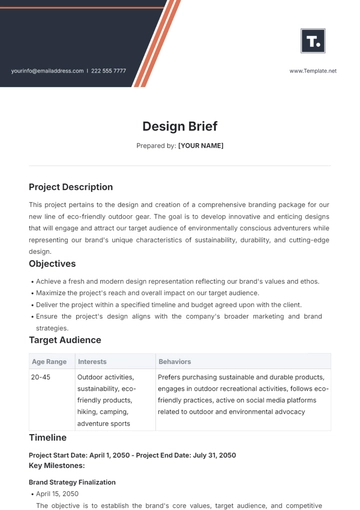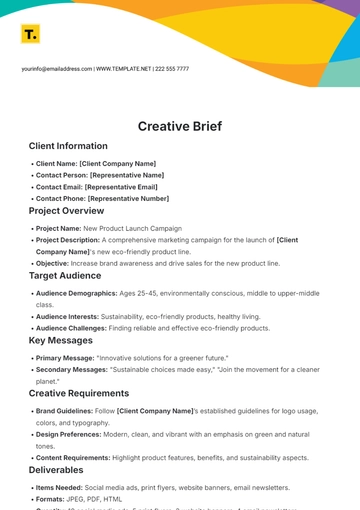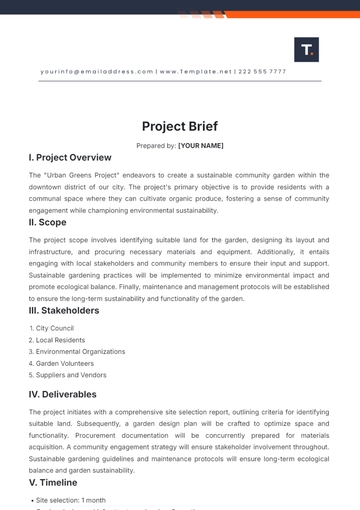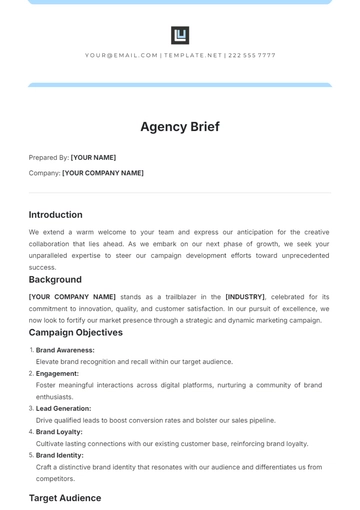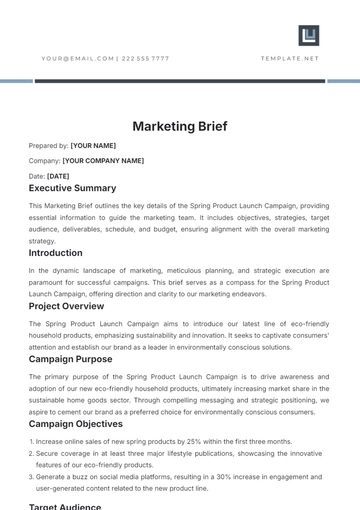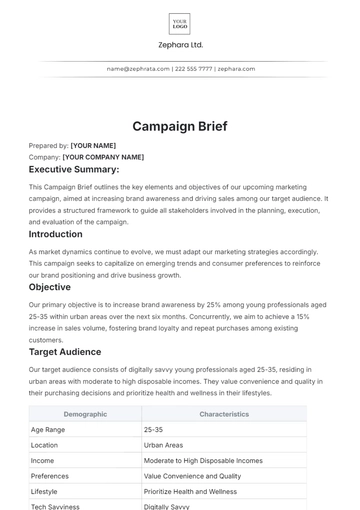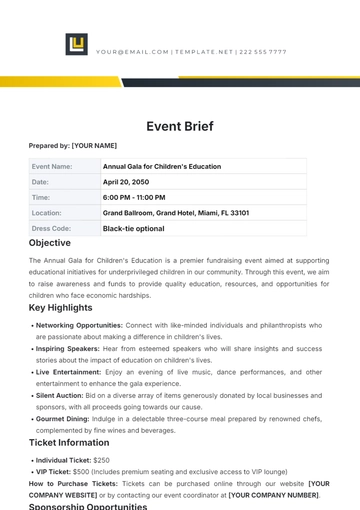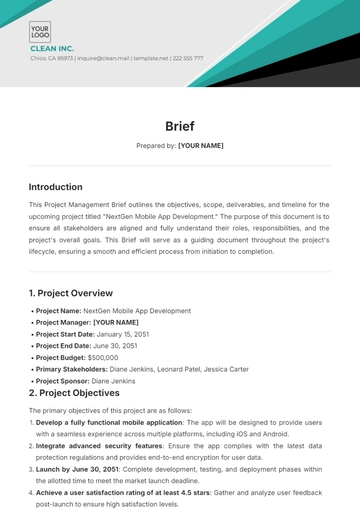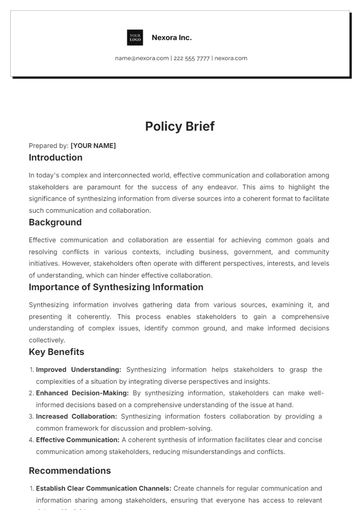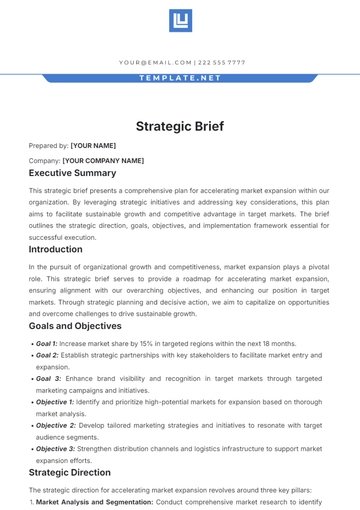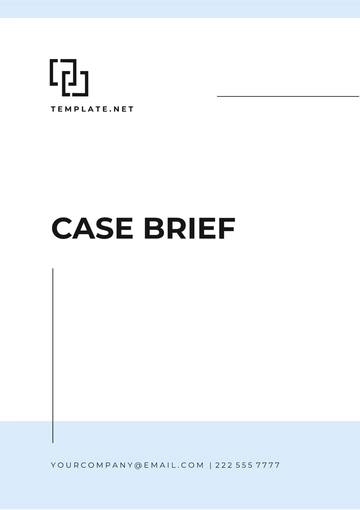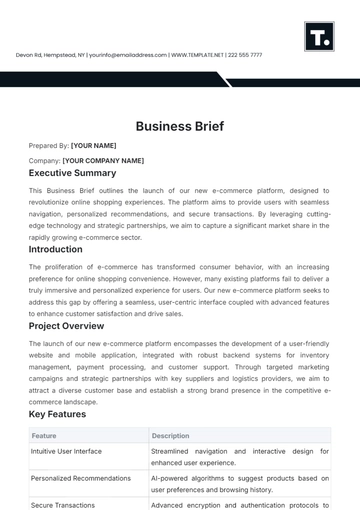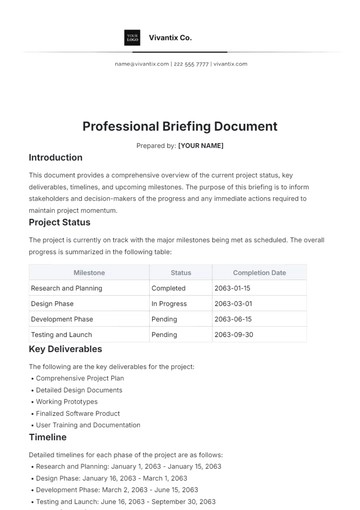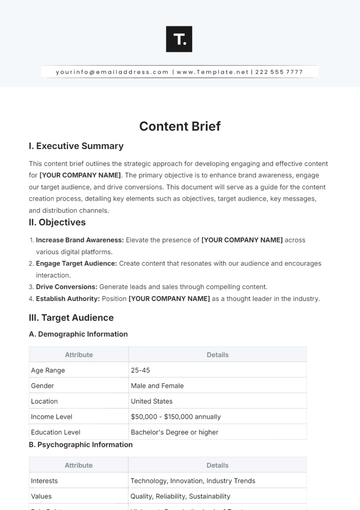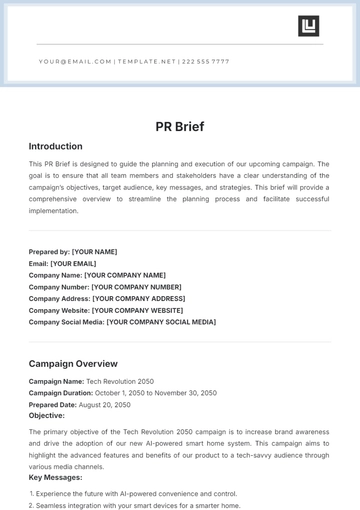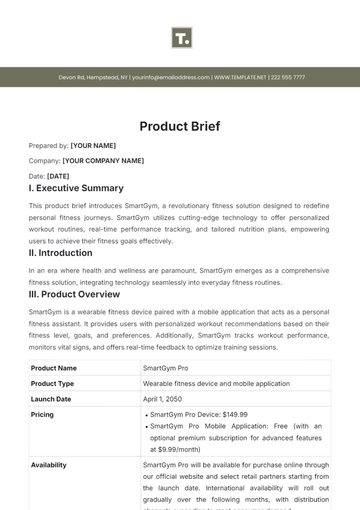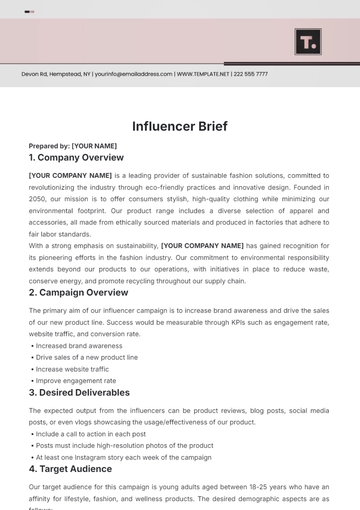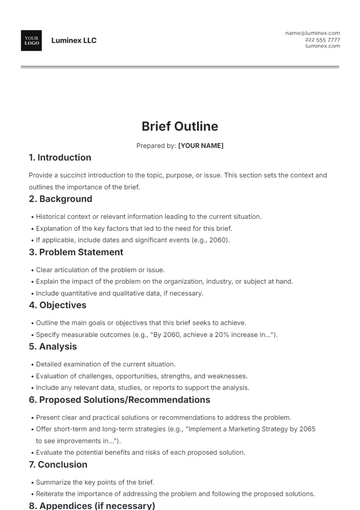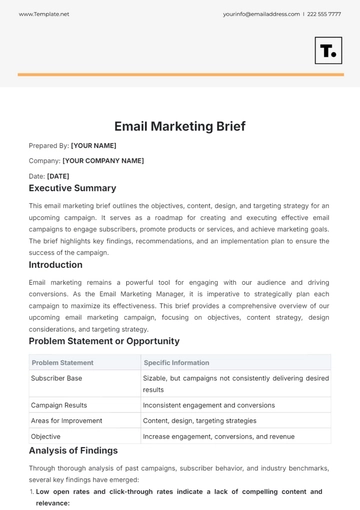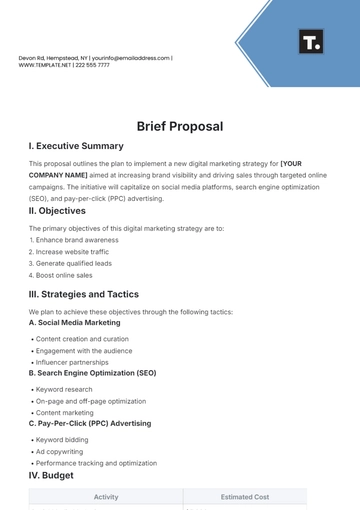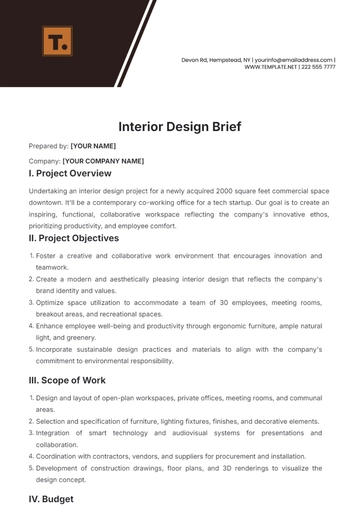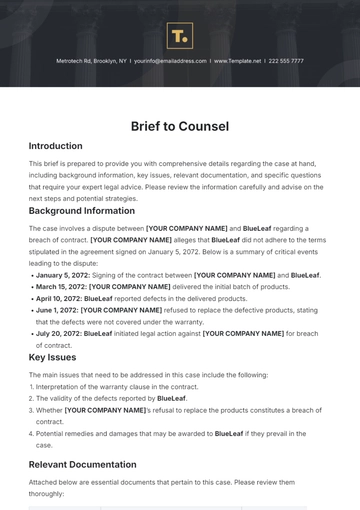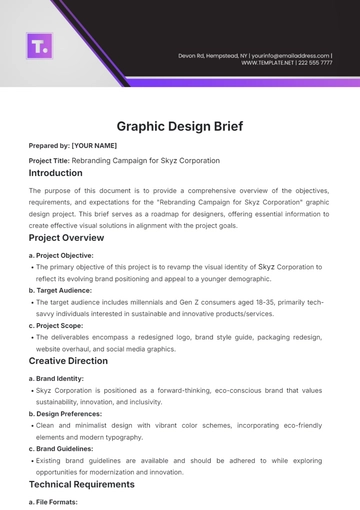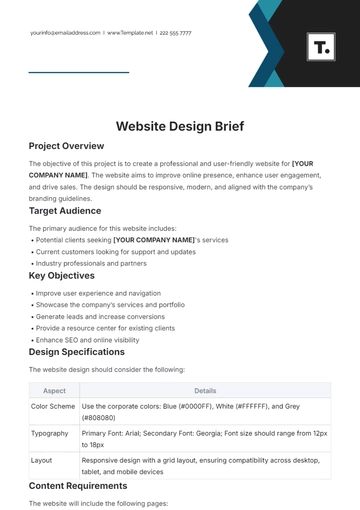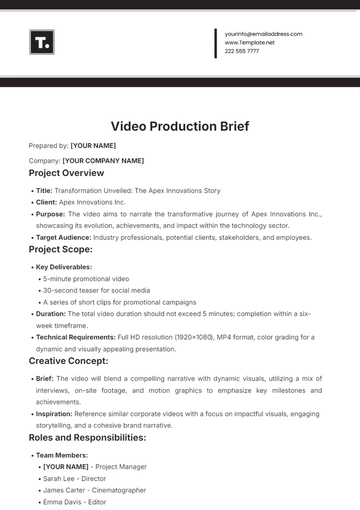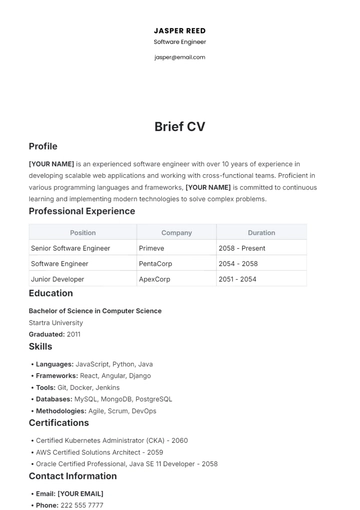Free Campaign Brief
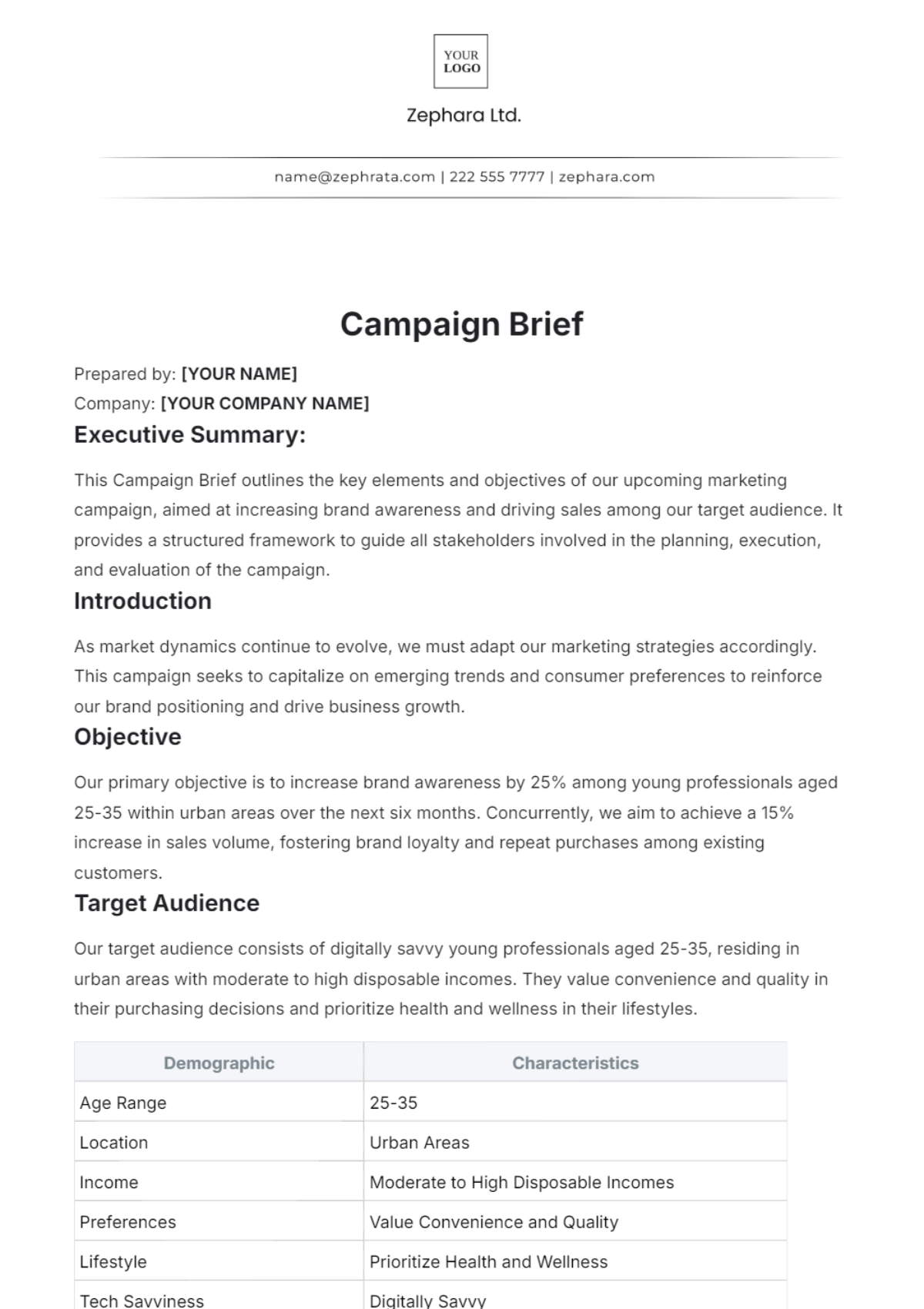
Prepared by: [YOUR NAME]
Company: [YOUR COMPANY NAME]
Executive Summary:
This Campaign Brief outlines the key elements and objectives of our upcoming marketing campaign, aimed at increasing brand awareness and driving sales among our target audience. It provides a structured framework to guide all stakeholders involved in the planning, execution, and evaluation of the campaign.
Introduction
As market dynamics continue to evolve, we must adapt our marketing strategies accordingly. This campaign seeks to capitalize on emerging trends and consumer preferences to reinforce our brand positioning and drive business growth.
Objective
Our primary objective is to increase brand awareness by 25% among young professionals aged 25-35 within urban areas over the next six months. Concurrently, we aim to achieve a 15% increase in sales volume, fostering brand loyalty and repeat purchases among existing customers.
Target Audience
Our target audience consists of digitally savvy young professionals aged 25-35, residing in urban areas with moderate to high disposable incomes. They value convenience and quality in their purchasing decisions and prioritize health and wellness in their lifestyles.
Demographic | Characteristics |
|---|---|
Age Range | 25-35 |
Location | Urban Areas |
Income | Moderate to High Disposable Incomes |
Preferences | Value Convenience and Quality |
Lifestyle | Prioritize Health and Wellness |
Tech Savviness | Digitally Savvy |
Campaign Theme or Concept
The campaign theme revolves around the concept of 'Wellness on the Go,' highlighting the convenience and health benefits of our products. It emphasizes the idea of maintaining a healthy lifestyle even amid busy schedules, resonating with the fast-paced lives of our target demographic.
Channels
We will leverage a mix of digital and traditional channels to reach our audience effectively. This includes social media platforms such as Instagram and Facebook for targeted advertising and engagement, email marketing for personalized communication, influencer partnerships to amplify our message, and strategic placement of advertisements on relevant online platforms.
Timeline
The campaign will kick off on April 1st, 2024, and will run for six months, concluding on September 30th, 2024. Key milestones include campaign launch, content creation, influencer collaborations, promotional events, and performance evaluation.
Date | Activity |
|---|---|
April 01, 2050 | Campaign Launch |
April 22, 2050 - May 13, 2050 | Content Creation |
June 04, 2050 | Influencer Collaborations |
July 10, 2050 - August 13, 2050 | Promotional Events |
September 11, 2050 | Performance Evaluation |
September 30, 2050 | Campaign Conclusion |
Budget
A total budget of $500,000 has been allocated for this campaign. This includes expenses related to content creation, advertising, influencer collaborations, promotional events, and analytics tools to track campaign performance effectively.
Category | Budget Allocation |
|---|---|
Content Creation | $100,000 |
Advertising | $200,000 |
Influencer Collaborations | $50,000 |
Promotional Events | $75,000 |
Analytics Tools | $75,000 |
Total | $500, 000 |
Metrics for Success
Success will be measured through various key performance indicators (KPIs) including brand awareness metrics (reach, impressions), website traffic (visitors, bounce rate), social media engagement (likes, shares, comments), and sales figures (volume, revenue). Regular analysis of these metrics will guide decision-making and optimization efforts throughout the campaign.
Creative Guidelines
Creatives should align with the campaign theme of 'Wellness on the Go,' incorporating vibrant visuals, relatable messaging, and a focus on convenience and health benefits. Consistency in branding and messaging across all channels is crucial to ensure effective communication with our audience.
Key Stakeholders
Key stakeholders involved in the campaign include the marketing team, creative agency, product development team, sales team, and senior management. Clear communication and collaboration among these stakeholders are essential to ensure alignment and successful execution of the campaign.
Risks and Challenges
Potential risks and challenges include changes in market dynamics, competitive pressures, and technical issues with digital platforms. Mitigation strategies such as contingency plans, regular monitoring, and agile decision-making processes have been put in place to address these risks effectively.
Changes in Market Dynamics:
Fluctuations in consumer preferences and economic conditions may impact the effectiveness of our campaign strategies.
Mitigation Strategy: Regular market research and trend analysis to anticipate changes, allowing for agile adjustments to our approach.
Competitive Pressures:
Intense competition within our industry may result in challenges in standing out and capturing market share.
Mitigation Strategy: Continuous monitoring of competitor activities and differentiation of our offerings through unique value propositions and innovative marketing tactics.
Technical Issues with Digital Platforms:
Potential disruptions or glitches in digital platforms (e.g., social media, website) may hinder our ability to reach and engage our target audience effectively.
Mitigation Strategy: Implementing robust technical infrastructure, regular testing, and having backup plans in place to swiftly address any technical issues that arise.
Conclusion
In conclusion, this Campaign Brief provides a comprehensive roadmap for our upcoming marketing campaign, outlining objectives, strategies, and key considerations for success. By leveraging the strengths of our team and resources while remaining agile in our approach, we are confident in achieving our goals and driving significant business impact.
- 100% Customizable, free editor
- Access 1 Million+ Templates, photo’s & graphics
- Download or share as a template
- Click and replace photos, graphics, text, backgrounds
- Resize, crop, AI write & more
- Access advanced editor
Introducing the Campaign Brief Template from Template.net, your go-to solution for strategic planning. Fully editable and customizable, this template allows seamless adaptation to your campaign needs. Integrated with our Ai Editor Tool, precision editing is effortless, ensuring your strategies are executed flawlessly. Simplify your campaign planning process and achieve unparalleled results with this indispensable resource.
